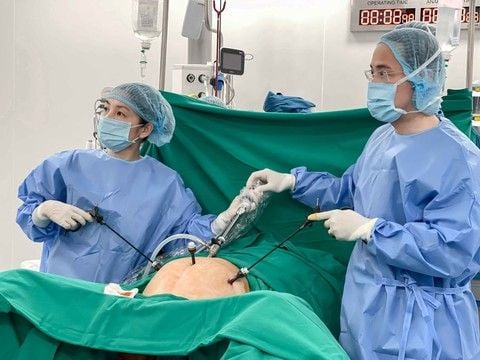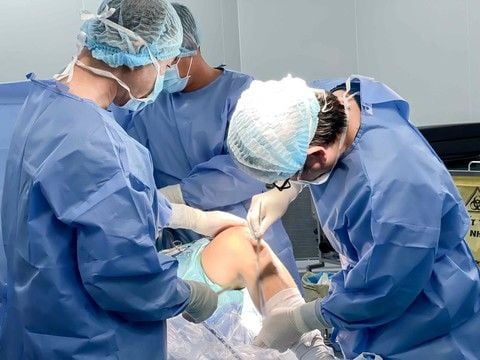Diarrhea or bloody stools accompanied by fever and abdominal cramps are signs of dysentery in children. This is a common diarrheal condition that often requires hospitalization and intensive treatment from the outset to prevent dehydration and fatigue.
1.What is the condition of dysentery in children?
Dysentery is defined as diarrhea with blood in the stool. The most common cause of acute dysentery in children is Shigella, particularly S. flexneri and S. dysenteriae type 1. Other causes that can lead to dysentery in children include Campylobacter jejuni, especially in neonates, and less commonly, Salmonella.
Certain agents such as invasive E. coli bacteria, are closely related to Shigella infection and can cause severe dysentery in children. However, the likelihood of infection with this agent is uncommon. Meanwhile, Entamoeba histolytica causes dysentery in older children and adults, but is rare in children under 5 years old.
In cases of diarrhea, dysentery is a serious condition in children. Approximately 15% of all diarrheal episodes in children under 5 years of age and contributes to up to 25% of all diarrheal-related mortality.
Moreover, dysentery is particularly severe in infants and children who are malnourished, exhibit clinically apparent dehydration during illness, or are not breastfed. Additionally, dysentery in children has a greater impact on nutritional status than acute diarrhea. Furthermore, signs of dysentery occur more frequently and with greater severity in children with measles or those who have recently recovered from measles within the past month. Diarrheal episodes that begin with dysentery tend to be more protracted and persistent than those that start with normal watery stools.
2. What are the signs of dysentery in children?
The clinical signs of dysentery in children are determined by the presence of visible blood in the diarrheal stools. The stools will also contain numerous pus cells (neutrophils) visible under the microscope and a significant amount of mucus. These characteristics indicate that the child has been infected with an invasive bacterial pathogen affecting the intestinal mucosa, such as Campylobacter jejuni or Shigella.
In a typical episode, the signs of dysentery in children begin with watery stools, which may turn bloody after one or two days. Diarrhea with watery stools can sometimes be severe and lead to dehydration. However, in most cases, if the child passes small stools with blood, severe dehydration does not occur.
Additionally, children with dysentery often experience fever, although the temperature may be abnormally low, especially in severe cases. On the other hand, the child may exhibit crampy abdominal pain and rectal pain during defecation or while attempting to pass stool (tenesmus). However, children under 5 years of age are unable to describe these symptoms.

3. What should be done if a child has dysentery?
In most cases, when signs of dysentery are detected in a child, the condition should be considered a Shigella infection and treated accordingly as soon as possible. This is because Shigella is responsible for approximately 60% of dysentery cases seen at healthcare facilities and nearly all severe, life-threatening cases.
At the same time, if a stool examination under the microscope reveals E. histolytica cells containing red blood cells, early initiation of basic dysentery treatment protocols should be considered, including antibiotics, fluid replacement, and careful monitoring.
- Antibiotic therapy
Early treatment of Shigella dysentery in children with an appropriate antibiotic can help shorten the illness duration and reduce the risk of severe complications and death. However, treatment is only effective when Shigella is sensitive to the prescribed antibiotic. In contrast, if treatment is delayed or if antibiotics to which Shigella is resistant are used, the bacteria can cause extensive damage to the intestines and invade the bloodstream, leading to sepsis, circulatory failure, and sometimes septic shock. These complications occur more frequently in malnourished children or neonates and can be fatal.
Young children with dysentery should not be routinely treated with anti-amoebic medications. Treatment should only be given when E. histolytica is identified with red blood cells in the stool or when blood persists in the stool despite treatment with two antibiotics that are generally effective against Shigella. The preferred treatment for amoebic dysentery is metronidazole. If the dysentery is caused by E. histolytica, improvement will typically occur within 2-3 days of starting treatment
- Fluid replacement in dysentery treatment for children
Children with dysentery should be assessed for signs of dehydration and given suitable treatment. All dysentery patients should be actively provided with fluids and other beverages during the illness, particularly if they have a fever.
- Nutrition for children with dysentery
Children with dysentery should continue to eat as usual to prevent or minimize nutritional deficiencies during the illness. However, feeding may be challenging as children often experience a loss of appetite.
Therefore, the mother should be encouraged to continue breastfeeding. Older children should be given small, frequent meals at least 6 times a day. It is important to encourage the child to eat and offer energy-dense, nutritious foods that the child enjoys. The child should be given one extra meal per day for at least 2 weeks after diarrhea resolves to ensure adequate nutritional recovery.
- Careful monitoring in children with dysentery
Most cases of dysentery in children will show significant improvement within 2 days after starting effective antibiotic treatment. These cases should complete the full 5-day treatment course and do not require careful monitoring.
However, other patients need to be carefully monitored, particularly those who do not show clear improvement within 2 days, or those known to be at high risk of mortality or other complications. High-risk children (i.e., neonates, malnourished children, children not breastfed, and any child with dehydration) should be regularly monitored, either on an outpatient basis or through hospitalization. Children with severe malnutrition associated with dysentery should be routinely hospitalized. If signs of dysentery do not improve after 2 days of initial antibiotic treatment, a different antibiotic should be considered.

4.What are complications of dysentery in children?
Severe and potentially fatal complications may occur in children with dysentery, particularly when caused by Shigella bacteria, including:
- Bowel perforation, intestinal dilation
- Rectal prolapse
- Seizures (with or without high fever)
- Sepsis, hemolytic-uremic syndrome
- Prolonged hyponatremia
A major complication of dysentery is rapid weight loss and worsening nutritional status. This occurs because, when a child has dysentery, it is often accompanied by a loss of appetite, while the body’s demand for essential nutrients increases to fight the infection and repair damaged tissues. Furthermore, malnourished children may also experience loss of serum protein due to damage to the intestines.
Fatal outcomes in children with dysentery are often due to widespread intestinal damage involving the ileum and colon, complications such as sepsis, secondary infections (e.g., pneumonia), or severe malnutrition. Children treated for dysentery are also at increased risk of death from other infections, possibly due to poor nutritional status or compromised immune function.
In summary, dysentery in children is a significant cause of diarrheal illness. The typical signs of dysentery in children include watery stools with blood, accompanied by fever, leading to dehydration and malnutrition. Poor sanitation often increases the risk of dysentery due to the transmission of parasites or pathogenic bacteria through food or water. Therefore, to prevent the disease, parents should ensure proper hygiene for the child, including frequent handwashing with soap.
References: medbroadcast.com, sites.kowsarpub.com, rehydrate.org
LAMINKID I health supplement:
This product has the effect of supplementing essential minerals and vitamins for the body. It supports digestion, enhances food absorption, and helps improve appetite in children. It also helps boost immunity and reduces the risk of diseases due to poor immune function, such as upper respiratory tract infections and the common cold.
Target Users:
Children with poor appetite, low food absorption, underweight, malnutrition, and developmental delays.
Children with weak immunity, those who are sick or recovering from illness, and those frequently suffering from upper respiratory tract infections or colds.
Responsible for product quality:
Elepharma Pharmaceutical Joint Stock Company
No. 9, Truong Cong Giai Street, Group 17, Dich Vong Ward, Cau Giay District, Hanoi, Vietnam
(Phone) 1800 6091; (Email) info.elepharma@gmail.com
For more product information, visit: https://i.vinmec.com/laminkid
Register for nutrition consultation for your child at: https://i.vinmec.com/dangkytuvandinhduong
To arrange an appointment, please call HOTLINE or make your reservation directly HERE. You may also download the MyVinmec app to schedule appointments faster and manage your reservations more conveniently.








